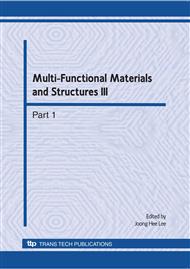p.971
p.975
p.979
p.983
p.987
p.991
p.995
p.999
p.1003
Investigations on a Smart Nano-Energy Absorption System
Abstract:
In this work, a smart nano- energy absorption system (nano-EAS) based on the liquid penetration/exudation in/from lyophobic nanoporous solids is proposed and its characteristics are theoretically and experimentally investigated. Damping properties of such smart nano-EAS can be reversibly, rapidly and significantly changed in a controlled fashion by external stimuli such as pressure, electric or magnetic fields, etc. Desired changes of the damping properties are induced by controlled variation of the surface tension of the liquid and/or the associated lyophobic solid, and/or by adjustment of the size of the nanopores. Variation patterns of the energy loss versus the applied pressure and the fluctuation rate of the pore radius are illustrated. Then, sensitivity of the proposed smart nano-EAS is evaluated.
Info:
Periodical:
Pages:
987-990
Citation:
Online since:
August 2010
Authors:
Price:
Сopyright:
© 2010 Trans Tech Publications Ltd. All Rights Reserved
Share:
Citation:


